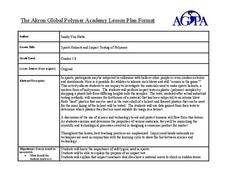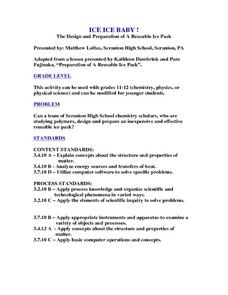LABScI
Viscosity: The Fluid Lab
There's more to fluids than meet the eye—they include gases, liquids, and polymers, too! Scholars complete three hands-on activities exploring different properties of fluids. They explore viscosity by measuring the resistance, or...
Curated OER
How Are Polymers Utilized in Everyday Life?
Students identify the different types of polymers. In this chemistry lesson, students research information about an area of polymer science they chose. They create a PowerPoint presentation to share their findings in class.
American Chemical Society
Man and Materials Through History
From the start of the Industrial Revolution, it only took 147 years for someone to invent plastic. This may seem like a long time, but in the history of inventing or discovering new materials, this is incredibly fast. An informative and...
Curated OER
The Study of Molecular Orientation by Linear Dimension Change of Polymeric Films
Students investigate the linear dimension change of heated plastic film and relate the results to processing and service use of the materials. They calculate percent change in dimension as related to anisotropy and molecular reorientation.
Curated OER
Determination of Plasticizer in PVC
Learners isolate and determine the amount of plasticizer in polyvinyl chloride. They use Infrared Spectroscopy (IR) or Fourier Transform Infrared Spectroscopy (FTIR) and gravimetric techniques in this experiment.
Curated OER
Slime and Intermolecular Attractions
Learners explore the strength of intermolecular attractions. They make slime and compare the difference in the physical properties of sheet and powdered polyvinyl alcohol with polyvinyl acetate.
Curated OER
Elements Of Chemistry: When Carbon Combines
Students create a polymer using Borax and Elmer's Glue. In this chemistry lesson, students identify monomers made of hydrocarbons and then brainstorm a list of polymers and their uses.
Curated OER
From Polymers to Bioplastics: Looking Toward Finding Renewable Resources
Students investigate the properties of polymers. In this chemistry lesson, students explain the importance of energy sources. They produce a bioplastic from the lab and evaluate its structural integrity.
Curated OER
Polymer Rockets
Students examine polymer rockets and complete an activity. In this rockets activity students design, create and test a polymer rocket and have a blast off competition.
Curated OER
Sports Helmets and Impact Testing of Polymers
Learners examine the importance of good quality safety gear. In this investigative lesson, students will tests various polymers, collect data, and analyze the data to determine which polymer is best for safety helmets. They will design a...
Curated OER
Fabrics and Polymers
Students explore natural resources by reading a science story in class. In this fibers lesson, students identify and discuss the differences between fibers such as wool, silk, rayon, linen and cotton. Students identify the common uses of...
Curated OER
Introduction to Materials Science - Part B
High schoolers are able to give specific examples of what to do and what not to do during given safety situations, and classify materials as metals, polymers, ceramics/glass, or composites. They are able to distinguish between chemical...
Curated OER
Observation Milk Fat Lesson
Turn your class loose to experiment with the different fat content in skim milk, whole milk, half and half, and heavy cream. This is a visually vibrant experiment, as learners drip food coloring on the surface of the products and measure...
Curated OER
How to Clean Up an Oil Slick
Students explore how an oil spill is contained and cleaned up. They investigate an oil absorbing polymer that is hydrophobic, absorbs up to 19 times its own weight in nonpolar liquids, floats on water, and can be reused or disposed of by...
Curated OER
The Four Groups of Biologically Important Compounds
This is not they typical set of teacher instructions. It is an organized chart of the important organic compounds. For each, the involved elements, the name of the building block monomers, the names of polymers, extra information, and a...
Curated OER
Slime and Polymers
Students participate in an experiment to demonstrate how mixing certain chemicals together can change the consistency of both chemicals. Glue, water, and borax are used to create a slime-like substance which is examined to determine how...
Curated OER
The Polymer Schoolhouse
Students investigate polymers by discovering and examining plastics and creating a diorama.
Curated OER
Exploring the Physical and Chemical Properties of Polymers
Students determine the physical and chemical properties of polymers. In this chemistry lesson, students test them for biodegradability. They collect data and compare their results.
Curated OER
Catering Middle-School Science: Monomers, Polymers, and Macromolecules
Students investigate foods. In this biology lesson plan, students will conduct testing on different types of foods as they learn about different molecules that make them up. Students will also learn about the shapes of the molecules.
Curated OER
Ice Ice Baby! The Design and Preparation of A Reusable Ice Pack
Pupils explore polymers by designing and preparing an inexpensive and effective reusable ice pack. They develop and test a design for a reusable ice pack in the science lab. Students apply chemical and physical properties of polymers and...
Curated OER
Sports Helmets and Impact Testing of Polymers
Students test various polymers resistance to impact. In this technology lesson plan, students collect data and formulate a conclusion. They design their own helmet and present it to class.
Curated OER
Polymers
Learners explore online tutorial on polymers. In this chemistry lesson, they create two polymers in the lab and compare their properties. They write a sales letter about their new and improved polymer product.
Curated OER
Polymers and Crystals
High schoolers experiment with crystals and polymers and examine their roles in food science.
Curated OER
Polymers and People
Students identify a historical example of how advances in science depend on advances in technology and vice versa.

























